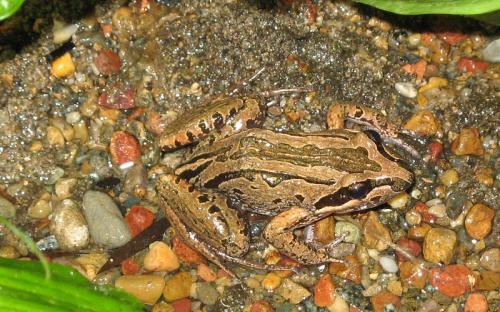Conservation status: least concern
What do they look like?
A large frog that can grow up to 7.5cm in length. They have a brown back with darker brown longitudinal stripes and spots, sometimes with a cream coloured or red stripe along the middle of the back. They have a white belly and a pale stripe running from under the eye to the top of their arm. The males have a yellow throat with brown mottling.
What to listen out for
A single ‘pop’ or ‘tok’ sound repeated every few seconds, often compared to the sound of a ball hitting a tennis racquet. They call most commonly from September all the way through to April, but can be heard all year round if there is heavy rainfall and they are not hibernating.
LISTEN:
https://www.facebook.com/watch/?v=1563621360402344
https://www.youtube.com/watch?v=dpgGvMu7Qzo
Where to find them
Striped Marsh Frogs prefer to live in and around more permanent sources of water like ponds, lakes and even swimming pools. They live amongst reeds, leaf litter and in fallen logs. They are found around the coast of New South Wales, Queensland and Victoria, as well as southeast South Australia and northern Tasmania.
You can spot them in Bayside at the Tulip Street Pond (near the Sandringham Leisure Centre), Pobblebonk Park (George St, Sandringham) and Yalukit Willam Nature Reserve (Elsternwick). Listen for their calls in Spring, Summer and Autumn.
Life Cycle
The Striped Marsh Frog’s breeding season lasts from September to April, during warmer weather, as many hibernate in Winter. Females lay their eggs as a foamy mass on the surface of bodies of still water, often hidden under vegetation around the edges of the water. Tadpoles can reach up to 9.5cm in length and usually remain at the bottom of water bodies. They take between 7 to 8 months to mature into frogs. Tadpoles are dark brown or black in colour.
Did you know?
• Striped Marsh Frogs spend much of their Winter in hibernation. When hibernating they do not need to eat, as they expend so little energy.
• Striped Marsh Frogs are very hardy and adaptable and appear to be more tolerant of polluted water than most frogs. This however does not mean we shouldn’t be keeping our waterways clean.
Download our factsheet
FoNW Factsheet - Striped Marsh Frog
References and Further Reading
https://www.frogid.net.au/frogs/limnodynastes-peronii
https://backyardbuddies.org.au/backyard-buddies/striped-marsh-frog/
https://australian.museum/learn/animals/frogs/striped-marsh-frog/
Credits
Author: Nykita Ivanoff
Photo cskk https://www.flickr.com/photos/cskk/3353643516 CC BY-NC-ND

